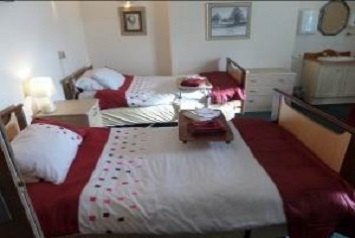
The evacuation of Care Homes in case of fire is often difficult, as a high proportion of the residents are usually either physically or neurologically impaired (or both).
Whilst progressive evacuation is the preferred fire evacuation strategy for most Care Homes (moving residents to relatively safe fire compartments within the Home rather than immediately evacuating all to an external area), the golden 2 ½ minute initial evacuation time for the affected room remains of key importance.
Within a Residential Care Home the fire evacuation process usually comprises of the following events: –
- The clock starts ticking when the fire alarm activates (or a member of staff/visitor/resident raises the alarm).
- A member of staff attends the fire panel and identifies where the fire alarm activation occurred.
- Staff are directed to the affected bedroom (or zone in a worst case scenario), which, for example, could be on the third floor at the far end of the Home.
- The assisted evacuation of the resident commences, usually involving the man handling of the resident in to a wheelchair.
Considering the above, it can be a tall order for Care Home staff to get a resident out of the bedroom within the 2 ½ minute time frame (i.e. the time period associated with manageable smoke conditions within the room). Sadly, the result of delayed attendance to a fire in a residents’ bedroom can be the loss of life.
With regards to double bedrooms, there is very little in terms of guidance within the Governments’ Residential Care Home Guide. Therefore, reference should be made to the Building Regulations 2010 and the guidance published in support of the regulations, Approved Document B, which states: –
‘3.49 Bedrooms should not contain more than one bed (this includes a double bed).’
This paragraph sits within a section of the Approved Document guidance specifically dedicated to Residential Care Homes. Whilst it’s important to recognise that Building Regulations do not apply retrospectively to existing premises, it is important to note that this guidance is a benchmark of current thinking.
Where there are double bedrooms, Fire Risk Assessments need to recognise the risk of an additional life being lost and should consider, in conjunction with the Care Home Manager: –
- The dependency of the residents within the bedroom, in terms of their evacuation needs, not day to day care arrangements (a resident who is hoisted for the purposes of day to day care would not normally be hoisted in an emergency situation).
- What type of fire alarm system is in place (a traditional zoned only system or addressable and whether or not there is remote monitoring in place).
- Where the bedroom is located in relation to the fire alarm panel (consider both the floor level and travel distances involved).
- The number of staff available to assist, considering a ‘worst case’ night time fire.
- Evacuation times achieved by the home during previous simulated evacuations.
If the conclusion of the above assessment is that two lives are likely to be lost, then the bedroom should only be occupied by relatively mobile residents who could self-evacuate or be occupied on a single person basis.
There is an option suggested within the guidance, to provide sprinkler protection within double bedrooms (fixed and portable mist sprinklers are available), but this can be a costly option.
The issue surrounding the evacuation of occupied double bedrooms does not appear to be on the ‘radar’ for neither Enforcing Authorities nor the majority of Fire Risk Assessors. So the question is, Double Bedrooms, What’s the Problem? The potential consequences are life threatening, this is why it is recognised within the Building Regulations and the Approved Document B; it shouldn’t be ignored, it should ALWAYS be a consideration!
Posted by: Adrian Gouldin Bsc (Hons) MRICS GIFireE, Marpal’s Head of Fire Safety & IFE registered Fire Risk Assessor.
For further information on Fire Safety, please contact Adrian Gouldin by phone (01332 668877) or email ([email protected]).

